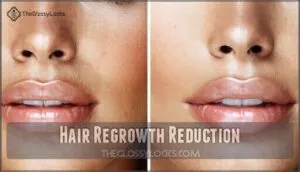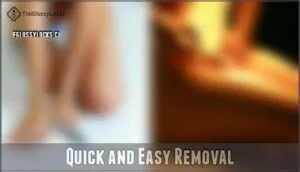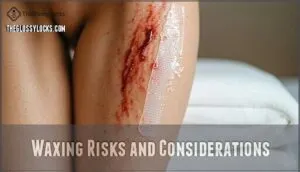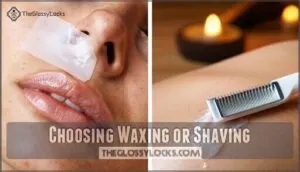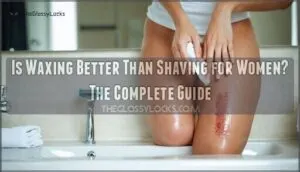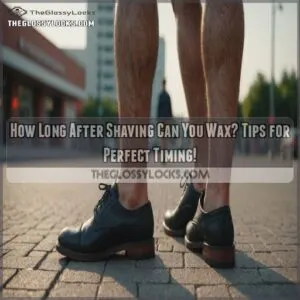This site is supported by our readers. We may earn a commission, at no cost to you, if you purchase through links.
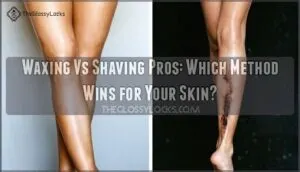
Waxing gives you weeks of smooth skin and weakens hair over time, but it’s like ripping off a band-aid every month.
Shaving offers instant results with zero pain, letting you stay in complete control of your routine.
You’ll trade convenience for frequency though – shaving means daily touch-ups while waxing buys you three to six weeks of freedom.
Your skin type, pain tolerance, and lifestyle determine which method wins, considering surprising factors that can tip the scales in ways you might not expect, ultimately affecting your choice for smooth skin.
Table Of Contents
- Key Takeaways
- Waxing Vs Shaving Basics
- Benefits of Waxing
- Shaving Pros and Cons
- Waxing Risks and Considerations
- Choosing Waxing or Shaving
- Frequently Asked Questions (FAQs)
- Is waxing actually better than shaving?
- What are the advantages of waxing over shaving?
- What are the disadvantages of waxing?
- Do doctors recommend shaving or waxing?
- Can pregnant women safely wax or shave?
- Which method works better for facial hair?
- How often should you replace razor blades?
- Does waxing hurt more than tattoos?
- Can you wax immediately after shaving?
- Conclusion
Key Takeaways
- Waxing lasts longer and weakens hair over time, but it’s painful and requires hair to grow out before each session.
- Shaving is quick, painless, and budget-friendly, but you’ll need to touch up daily to maintain smooth skin.
- Waxing removes hair from the root and exfoliates dead skin, leaving smoother results compared to shaving.
- Your choice depends on your pain tolerance, skin sensitivity, budget, and how often you want to remove hair.
Waxing Vs Shaving Basics
You need to understand the key differences between waxing and shaving before choosing your hair removal method.
Waxing pulls hair from the root using heated wax, while shaving cuts hair at the skin’s surface with a razor.
Waxing goes deep while shaving stays surface-level – two completely different approaches to smooth skin.
Hair Removal Processes
When choosing between hair removal methods, understanding the fundamental processes helps you make informed decisions.
Waxing pulls hair from the root using heated wax, while shaving cuts hair at skin level with razor blades.
| Process | Hair Regrowth | Method Longevity |
|---|---|---|
| Waxing | 3-6 weeks | Long-lasting |
| Shaving | 1-3 days | Short-term |
| Trimming | 3-7 days | Medium-term |
Each method affects hair thickness and requires different pain tolerance levels for desirable results, making it essential to consider the longevity of each method and the overall hair removal experience.
Techniques and Tools
The right tools make all the difference in your hair removal journey.
Razor types range from disposable to electric models, while wax types include soft wax needing strips and hard wax that removes without them.
Your technique matters too – proper application methods and tool maintenance guarantee better results.
Maintaining grooming tools helps to prevent skin irritation.
| Method | Tools Needed | Application Method |
|---|---|---|
| Shaving | Razor, shaving cream, water | Wet skin, apply cream, glide razor |
| Soft Wax | Wax warmer, strips, spatula | Heat wax, spread thin, remove with strips |
| Hard Wax | Wax warmer, spatula | Heat wax, apply thick, remove directly |
Skin Preparation
Proper skin preparation sets you up for success with either method.
Your skin needs different care depending on your choice.
| Preparation Step | Waxing Tips | Shaving Tips |
|---|---|---|
| Pre-treatment | Pre-wax exfoliation 24 hours before | Wet skin with warm water |
| Hair length importance | Keep hair 1/4 to 1/2 inch long | Any length works fine |
| Sensitive skin prep | Skip retinol products beforehand | Choose gentle shaving cream type |
Skin hydration and hydration considerations matter most for smooth results.
You can buy products for effective skin exfoliation.
Benefits of Waxing
When you choose waxing over shaving, you’re getting results that last three to four weeks instead of just a few days.
You’ll also enjoy smoother skin since waxing removes dead skin cells while pulling hair from the root, giving you a natural exfoliation treatment with every session.
Longer Lasting Results
Waxing delivers a knockout punch in the matter of regrowth timeline.
You’ll enjoy smooth skin for three to six weeks, while shaving only gives you days before stubble returns.
This follicle impact creates significant frequency reduction – fewer sessions mean more freedom.
Hair density decreases over time, and hair texture becomes finer with consistent waxing vs shaving approaches.
Many users find that they get noticeable waxing results with continued use, achieving noticeable improvements.
Exfoliation Benefits
Beyond just removing hair, waxing delivers a bonus skincare treatment that shaving simply can’t match.
The wax pulls away dead skin cells along with unwanted hair, revealing smoother, brighter skin underneath. This dual-action process saves you time and money on separate exfoliation treatments.
- Skin Smoothing: Wax removes dead cells that make skin feel rough and look dull
- Dead Cell Removal: Natural exfoliation happens automatically during each waxing session
- Improved Appearance: Your skin looks brighter and feels softer after waxing treatments
- Enhanced Absorption: Exfoliated skin absorbs moisturizers and serums more effectively
- Circulation Boost: The waxing process stimulates blood flow, promoting healthier-looking skin
Hair Regrowth Reduction
One of waxing’s biggest advantages is its impact on hair regrowth patterns.
Unlike shaving, which cuts hair at surface level, waxing removes follicles entirely, disrupting your natural hair growth cycle.
This follicle damage leads to hair texture changes over time – regrowth becomes finer and sparser.
The regrowth rate comparison shows waxing’s long-term effects substantially reduce overall hair density.
Regular waxing can also weaken follicles, leading to slower, sparser regrowth.
Shaving Pros and Cons
Shaving offers the quickest path to smooth skin, taking just minutes in your shower with nothing more than a razor and some cream.
While you’ll save money and time compared to waxing, you’re trading convenience for potential skin irritation and the need to shave every few days, which can be a significant inconvenience.
Quick and Easy Removal
Shaving delivers immediate results in just minutes, making it perfect for your busy schedule.
You’ll appreciate the convenience factors – no appointments needed, minimal preparation required, and you can do it at home anytime.
The speed comparison is clear: while waxing takes an hour, shaving takes five minutes.
Plus, shaving benefits include zero pain tolerance requirements, unlike waxing’s discomfort, which highlights the importance of convenience factors.
Cost Effective Options
Your wallet will thank you for choosing shaving over waxing.
While professional waxing sessions cost $50-70 per visit, a quality razor runs just $10-50 upfront.
Here’s your hair removal cost comparison breakdown:
- Disposable razors – Under $5 for weeks of use
- Electric shavers – One-time $30-50 investment with years of razor longevity
- Shaving cream – $3-8 bottles last months
- DIY waxing kits – $20-30 but messier results than salons
- Long-term savings – Shaving costs 80% less annually than professional waxing
For those seeking economical options, consider the various brand prices.
Smart hair removal affordability starts with realistic product comparison shopping.
Skin Irritation Risks
Consider these skin irritation risks before choosing your method.
Razor burn creates uncomfortable redness, while ingrown hairs cause painful bumps after shaving.
Folliculitis risk increases with frequent blade use.
Shaving side effects include chronic irritation, whereas waxing side effects involve temporary inflammation and potential burns.
Waxing redness appears immediately post-treatment, and sensitive skin reacts poorly to both methods.
Waxing, however, offers longer lasting results compared to shaving, providing a longer lasting alternative with temporary inflammation and potential skin reacts.
Waxing Risks and Considerations
While waxing offers longer-lasting results than shaving, you’ll need to keep in mind several potential risks before choosing this method.
Your skin might experience pain, redness, irritation, or even infections, especially if you’re taking certain medications or have sensitive skin.
Skin Sensitivity Issues
Your skin sensitivity plays a vital role in choosing between waxing and shaving for hair removal.
Your skin’s unique needs should guide your hair removal choice – listen to what it’s telling you.
Sensitive areas like the face and bikini line require extra caution with both methods.
Key skin sensitivity considerations include:
- Allergic Reactions – Test products on small skin patches first
- Skin Conditions – Avoid waxing with eczema or dermatitis
- Post-Care – Use gentle moisturizers for irritation prevention
Infection and Ingrown Hairs
Both waxing and shaving carry infection risk if proper hygiene practices aren’t followed.
Waxing generally causes fewer ingrown hairs since it removes hair from the root, while shaving creates sharper ends that can curl back into sensitive skin.
Preventing infections requires clean tools and proper aftercare routines, and treating ingrowns promptly prevents painful, pus-filled bumps that need medical attention.
Shaving with improper technique can lead to trapped hairs under the skin, which is a key consideration for preventing infections.
Medication Interactions
Certain medications can throw your waxing plans off track.
Blood thinners like Warfarin increase bruising risks, while antibiotics such as doxycycline heighten skin sensitivity.
Retinol treatments and photosensitizing drugs make your skin more vulnerable to tearing.
Hormone replacement therapy can also affect how your skin reacts, and it is crucial to discuss topical medications with your aesthetician before booking your appointment.
Choosing Waxing or Shaving
Your skin type, hair texture, and personal schedule all play important roles in deciding between waxing and shaving.
Consider your pain tolerance, budget, and how often you want to remove hair when making this choice.
Suitable Skin Types
Your skin type plays a huge role in choosing between waxing and shaving.
If you’ve got normal skin, both methods work well.
However, those with skin sensitivity should lean toward shaving since it’s gentler.
People with acne prone, irritated skin, or sunburnt skin should avoid both until healed.
Retinol users face higher waxing risks.
Hair Type and Length
Your hair’s texture and thickness determine which method works best for you.
Fine hair responds well to both waxing and shaving, while coarse hair often needs the deeper removal that waxing provides.
For effective waxing, you’ll need hair that’s quarter-inch long – shorter won’t grip properly, and longer hurts more.
Fast hair growth rates favor waxing‘s longer-lasting results.
Those with sensitive skin might also consider safety razor options to minimize irritation.
Personal Preference Factors
Your pain tolerance plays a huge role in hair removal decisions.
If you can’t handle discomfort, shaving wins hands down.
Time commitment matters too – busy schedules favor quick shaves over lengthy wax appointments.
Budget constraints often tip the scale toward affordable razors.
Consider your desired smoothness level, hair thickness, and personal grooming goals when making aesthetic preferences that fit your lifestyle, including your lifestyle.
Frequently Asked Questions (FAQs)
Is waxing actually better than shaving?
Both methods have trade-offs.
You’ll get longer-lasting results with waxing, but it’s more painful and expensive.
Shaving offers convenience and affordability but requires frequent touch-ups.
Your choice depends on your priorities.
What are the advantages of waxing over shaving?
You’ll enjoy longer-lasting results with waxing since it removes hair from the root, keeping you smooth for three to four weeks.
Over time, your hair grows back finer and sparser than shaving.
What are the disadvantages of waxing?
You’ll experience significant pain during waxing, especially on sensitive areas.
Expect redness, irritation, and potential ingrown hairs afterward.
It’s expensive, time-consuming, and requires professional appointments.
Your skin might react poorly to the wax chemicals.
Do doctors recommend shaving or waxing?
Doctors don’t universally favor one method over another.
They’ll recommend shaving if you’ve got sensitive skin since it’s gentler.
Waxing gets the thumbs-up when you want longer-lasting results and can handle some discomfort.
Can pregnant women safely wax or shave?
Like ancient queens who maintained their beauty routines, you can safely wax or shave during pregnancy.
Both methods are generally safe, though your skin might be more sensitive.
Choose whatever feels comfortable for you.
Which method works better for facial hair?
Waxing works better for facial hair since it removes hair from the root, lasting 3-4 weeks. You’ll get smoother results and finer regrowth over time, though it’s more painful initially.
How often should you replace razor blades?
Like a sword losing its edge, your razor blade dulls with each use.
Replace disposable blades after five to seven shaves, while cartridge blades last seven to ten uses before they tug and irritate your skin.
Does waxing hurt more than tattoos?
Pain tolerance varies between people, but waxing typically hurts less than tattoos.
Waxing pain is sharp but brief, lasting seconds.
Tattoo pain is deeper and continuous for hours, making waxing more manageable overall.
Can you wax immediately after shaving?
No, you can’t wax immediately after shaving.
Your hair needs to be at least 1/4-inch long for wax to grip properly.
Wait three to four weeks after shaving before scheduling your first waxing appointment.
Conclusion
Deciding between waxing and shaving feels like choosing between a marathon and a sprint.
Waxing offers longer-lasting smoothness and weakens hair over time, but it’s not for the faint of heart.
Shaving, on the other hand, is quick, painless, and budget-friendly, though it demands daily upkeep.
Your skin type, hair texture, and tolerance for pain all play a role.
Weigh the waxing vs shaving pros carefully, and you’ll find the method that fits your lifestyle best.



